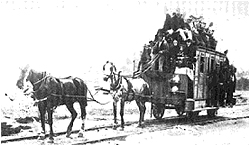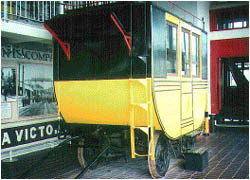
Sketch of Simon Llewellyn's 'car', built in 1819 -

These ran on the Mumbles line in Swansea

- this is a replica coach
Although it was always intended that the line should be steam powered, it was recognised that horses would provide the pulling power in the early stages. In the 1833 Journal of Agriculture, previously quoted it is pointed out that, "although at the time when this railway was constructing, the Stockton and Darlington railway was the only one which was in existence on the same principle, the workmanship of the Dundee and Newtyle one is very superior to any one even now in use. The using of large stone-sleepers to support the rails, the placing the rails high above the horse foot-track out of the reach of mud, and the peculiar mode in which the rails are keyed into the iron chairs, which prevents their starting up, are peculiarities and superior modes of workmanship on railways which were first exhibited here. Indeed, on the whole, this railway is a piece of work, both as to the direction of the line and the style of the workmanship, that reflects the greatest credit on the professional talents of the engineer."
It also gives some idea of the rolling stock. "Carriages for the conveyance of passengers are made of various forms, but they all move on the same kind of wheels as common waggons. There are close-bodied coaches, open vehicles with awnings, parcel waggons, and covered carts with benches, for poor people on market days. One horse trots with a number of them together at the rate of eight miles in the hour. Once we were conveyed along with sixty-four passengers by one horse at that rate. The motion in riding is not so smooth nor so noiseless as one might imagine; but this may be owing to the rails being placed on hard stone-sleepers, for on those parts where the wooden sleepers have not yet been removed, the motion is much smoother".
Horse drawn coaches for passenger transport appear to have been not uncommon. In The Mumbles Train it states that "On 25 March 1807, a railroad carriage converted to carry people was conveyed by horse along the perimeter of Swansea Bay, travelling between "the dunes" at Swansea, and destined for Mumbles, an oyster harvesting and fishing village on the west of the bay. The people who undertook this journey were unknowing pioneers - they were the first railway passengers in world history."
 Sketch of Simon Llewellyn's 'car', built in 1819 - |
 These ran on the Mumbles line in Swansea |
 - this is a replica coach |
Please feel free to contact me by e-mail at elliottsimpson@hotmail.com
May 2019